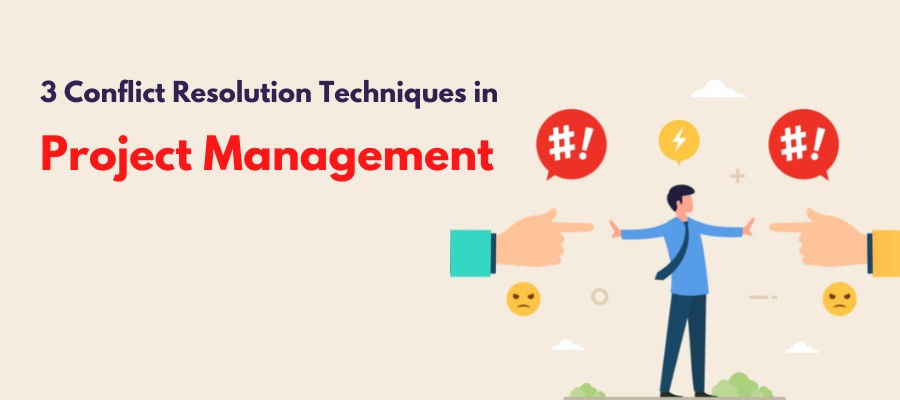3 Conflict Resolution Techniques in Project Management

Facing conflicts among Agile teams is a common thing to happen in all types of organizational projects. Generally, a conflict signals the differences between the team members while working for the same Product Goal. Still, conflicts can arise for various reasons such as:
- Differences in opinions during Sprint Planning
- Focusing on individual goals instead of the team’s goals
- Facing challenges to complete a development activity
- Having an unclear understanding of the Product Vision
- Low inter-team or intra-team communication
Still, conflicts are great to boost the Agile team’s productivity by overcoming the differences and challenges altogether. However, an Agile Leader might face various challenges to resolve a dispute or conflict among the working teams. It might affect the overall project management process negatively. That is why the Agile Practitioner must know the effective conflict resolution techniques that can contribute to smooth Agile project management. Here we will discuss the top 3 most-used conflict resolution techniques by a Product Owner or Project Manager in Agile projects.
1. Stay Neutral Till The End
The most powerful technique to resolve conflicts among Agile teams is to stay neutral at all costs. Indeed, it’s your responsibility to deal with all project conflicts as an Agile Coach. But you need to make sure to not get biased while participating in the conversations with the Developers, Testers, Admins, and other Agile teams. You must remain detached from taking one party’s side while overlooking the other party’s interest.
So, how to stay neutral? By participating in end-to-end conversations and hearing out the complaints of both sides. You can set aside your personal viewpoints and preferences. Next, you can focus on gaining awareness of the whole situation. Evaluate and acknowledge the opinions of both sides. Keep a positive attitude and provide honest opinions for moving the conversations forward. This will help you garner all teams’ trust and look for the best-suited conflict resolution ideas.
2. Use “I” Statements
Conflicts can happen among more than one Developer and Agile Teams. It doesn’t matter which teams or which team members are having conflicts. As an Agile Leader, you must resolve the conflicts with a solution-focused conversation between all parties.
The “I” statements come into the picture when you convey your acknowledgment to the parties involved in major conflicts. Using “I” statements is very useful when the conflict is the result of some previous actions. It’s an effective way to resolve conflicts by encouraging the parties to re-press their opinions using “I” statements. The Agile Teams can use the following recipe of expression:
When the disagreement/conflict got triggered,
Express “I” feel as an individual,
and What “I” think can resolve the conflict with a positive outcome.
These expressions provide the Agile Practitioner Teams in conflict with a powerful tool to express individual viewpoints and emotional perspectives clearly. As the “I” statements express an individual’s personal opinions there are fewer chances of offending any other person. Hence the Product Owner or the Project Manager should encourage teams to use appropriate “I” statements to express their views in team meetings like Daily Scrum, Sprint Restorective, etc.
3. Reframe the conflicts with solution-focused conversations
Reframing the conflicts in a unique technique used by most Product Owner and Agile Leader to remove the win/loss mentalities from the involved parties. It gives everybody equal opportunities to clarify their positions in a positive yet constructive manner.
How to move towards solution-focused conversations?
The first step is to involve all the parties in a detailed conversation that sheds light on the main problems. Rather than finding out who is right/wrong, the professionals should present the conflict as a common problem that requires immediate resolution. If all parties agree, then they can begin collaborating with each other to solve common problems. In this way, the whole situation stays transparent to all Agile Teams.
How to re-frame a conflict?
The most effective way when re-framing a conflict is to ignore the potential solutions at the beginning. The Agile Leader must focus on acknowledging the problems reported by both sides to bring up the best solution ideas. Involve all parties to suggest solutions for resolving the conflicts. This also helps in reframing the entire situation positively.
Summing Up: How to Take Conflicts as Improvement Opportunities?
Managing Agile Teams of Developers, System Admins, Testers, UI Designers, etc. is itself a challenging task for the Product Owner or Agile Leader. Often, teams will encounter conflicts between each other or with the requirements of the business analysts or stakeholders. Hence, you must learn useful conflict resolution techniques to utilize them in times of need as a professional Agile Coach.
We have already discussed three main conflict resolution techniques. But how to utilize the conflicts as improvement opportunities? Conflicts actually bring the Agile Teams closer as they are forced to work collaboratively to find resolution solutions. Thus, conflicts help improve inter-team and intra-team communications that facilitate the project’s overall productivity. All find themselves equally responsible to follow the product Goal with dedication. Hence Agile Coaches should start practicing these conflict resolution techniques and improve the overall team performance.
Reference
- https://www.linkedin.com/pulse/6-conflict-resolution-techniques-agile-coach-ramon-davila



